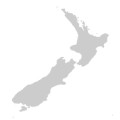Sedum album
L.Loosely tufted, mat-forming subshrub; stems to 18 cm long, ascending, light green or reddish, rooting at nodes. Leaves somewhat scattered, linear-cylindrical to ovoid-globose, 4–12 mm long, thick, somewhat flattened on the upper surface, obtuse, mid green, often reddish. Inflorescence a dense terminal subcorymbose cyme to c. 6 cm long. Flowers 1.5–3 mm diam., pedicellate; sepals ovate, c. 1 mm long; petals lanceolate-elliptic, 2–4 mm long, ± acute, white, rarely pink; stamens 10. Follicles c. 2.5–3 mm long, erect, whitish-pink. Flowers Dec.–Feb.
VVP, GipP, OtP, WaP, CVU. Native to the Mediterranean region. Naturalised in Victoria at Ballarat, Barwon Heads, Mt Eliza, Orford, and Willis. Plants have apparently escaped from nearby gardens or established from dumped garden refuse.


